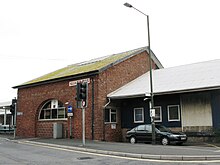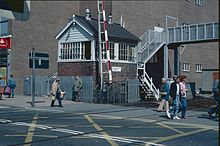| Paignton | |||||
|---|---|---|---|---|---|
 | |||||
| General information | |||||
| Location | Paignton, Torbay England | ||||
| Coordinates | 50°26′06″N 3°33′54″W / 50.435°N 3.565°W / 50.435; -3.565 | ||||
| Grid reference | SX889605 | ||||
| Managed by | Great Western Railway | ||||
| Platforms | 2 National Rail, 1 Heritage Railway | ||||
| Other information | |||||
| Station code | PGN | ||||
| Classification | DfT category C2 | ||||
| History | |||||
| Original company | Dartmouth and Torbay Railway | ||||
| Pre-grouping | Great Western Railway | ||||
| Post-grouping | Great Western Railway | ||||
| Key dates | |||||
| Opened | 1859 | ||||
| Passengers | |||||
| 2019/20 | |||||
| 2020/21 | |||||
| 2021/22 | |||||
| 2022/23 | |||||
| 2023/24 | |||||
| |||||
Paignton railway station serves the town and seaside resort of Paignton in Devon, England. It is 222 miles 12 chains (358 km) from London Paddington, via Box. It opened in 1859 and is now the terminus of Riviera Line services from Exeter and heritage services on the Dartmouth Steam Railway from Kingswear.
History

The railway to Paignton was built by the Dartmouth and Torbay Railway, opening to passengers on 2 August 1859 and extended to Brixham Road station on 14 March 1861. Goods traffic was handled at Paignton from 1 April 1861. The Dartmouth and Torbay Railway was always operated by the South Devon Railway and was amalgamated with it on 1 January 1872. This was only short-lived, as the South Devon Railway was in turn amalgamated into the Great Western Railway on 1 February 1876. The single-track line had been built using the 7 ft (2,134 mm) broad gauge, but on 20 May 1892 was converted to 4 ft 8+1⁄2 in (1,435 mm) standard gauge.
On 11 July 1904, GWR road motor services started running from here to Torquay, in competition with recently extended Torquay Tramways; the land opposite the station is still used as a bus station.
The line from Torquay was finally doubled in 1910, when the platforms were extended to accommodate longer trains. Further expansion came in 1924, with the opening of a larger booking office and new canopies were erected over the platforms. A few years later, the double track was extended to Goodrington and new carriage sidings opened behind the southbound platform. A new goods shed opened on 1 June 1931, just south of the station, which freed the original goods shed to deal with parcels traffic and passengers' luggage; this allowed the platforms to be extended further. In 1937, plans to move the station onto a new site south near the goods shed, which would have allowed five platforms to be constructed, failed to materialise due to World War II.
The Great Western Railway was nationalised into British Railways in 1948. In 1956, further carriage sidings were opened at Goodrington, which were used mainly to handle the heavy traffic on summer Saturdays.
The line from Paignton to Kingswear was sold to the Dart Valley Light Railway plc on 30 December 1972, which operated another nearby heritage railway at Buckfastleigh. An independent station alongside the main platform, known as Queens Park, was opened to serve the Kingswear trains on the site of the carriage sidings opened in 1930. This site includes a shed for the railway's operational engines and carriages. The line is now promoted as the Dartmouth Steam Railway.
Location

The station is sandwiched between two level crossings. At the north (Torquay) end of the station is the busy crossing over Torbay Road. It has a footbridge to allow people to cross the line on foot when the crossing is closed for a train to pass. At the opposite end is the quieter Paignton South (colloquially Sands Road) crossing, which is used when trains are running on to the carriage sidings or when the heritage line to Kingswear is in operation; consequently, the two lines over this crossing are operated as single tracks with trains running in either direction on both.
Both platforms have step-free access; passengers unable to use the footbridge are able to pass from one platform to the other over the Torbay Road level crossing at the north end of the platforms.
Platform layout
Most trains both arrive and depart from platform 2. If a train is not returning immediately towards Newton Abbot, it may arrive at platform 1 and continue over Sands Road Level Crossing into the carriage sidings, returning later to platform 2. This is because there is no crossover which allows passenger trains to start northwards from platform 1. It is possible for short trains to shunt out of platform 1 towards Newton Abbot and return to platform 2 when it is vacant.
The Dartmouth Steam Railway has its own independent platform and entrance on the south side of the station. Their locomotives are coaled in the shunting neck adjacent to the approach road but the shed is at the far end of the station.
Services

Most services at Paignton are operated by Great Western Railway. A frequent service is provided along the Riviera Line to and from Exeter St Davids, most of which continue on the Avocet Line through Exeter Central to and from Exmouth.
Great Western Railway also operates long-distance services to and from London Paddington and CrossCountry operate limited services to and from Bristol Temple Meads and Birmingham New Street. Passengers making long-distance journeys at other times change at Newton Abbot.
The Dartmouth Steam Railway operates services to and from Kingswear although these do not operate on certain days during the winter.
| Preceding station | Following station | |||
|---|---|---|---|---|
| Terminus | Great Western RailwayRiviera Line | Torquaytowards Exeter St Davids | ||
| Terminus | CrossCountry | Torquay | ||
| Goodrington Sands | Dartmouth Steam Railway | Terminus | ||
Former services
South West Trains operated up to three daily return services to/from London Waterloo for several years until December 2009 as extensions of their West of England line services to Exeter St Davids.
Signalling

Two signal boxes were opened in 1889, the 13-lever North Signal Box beside the Torbay Road level crossing, the 17-lever South Signal Box by the Sands Road level crossing. Both were replaced in 1924 by two new boxes. The North box closed on 26 March 1988 when control of trains was transferred to the Panel Signal Box at Exeter but the South box was retained to monitor the two level crossings. In 1990 this function was transferred to a panel in the station buildings and the signal box closed.
References
- Padgett, David (June 2018) . Munsey, Myles (ed.). Railway Track Diagrams 3: Western & Wales (6th ed.). Frome: Trackmaps. map 8C. ISBN 978-1-9996271-0-2.
- ^ Potts, C R (1998). The Newton Abbot to Kingswear Railway (1844–1988). Oxford: Oakwood Press. ISBN 0-85361-387-7.
- ^ Oakley, Mike (2007). Devon Railway Stations. Wimbourne: The Dovecote Press. ISBN 978-1-904349-55-6.
- "Citizens Rail". Retrieved 10 April 2014.
- Table 135 National Rail timetable, May 2016
- Table 51 National Rail timetable, May 2016
- "Scotland, North East & Manchester to the South West and South Coast". CrossCountry Trains. Retrieved 16 April 2023.
- "Dartmouth Steam Railway: Train Times" (PDF). dartmouthrailriver.co.uk. Retrieved 28 December 2022.
- Westcountry - Waterloo: the real alternative (PDF) (Report). Travel Watch South West. 2005. Retrieved 22 January 2021.
Bibliography
- Beck, Keith; Copsey, John (1990). The Great Western in South Devon. Didcot: Wild Swan Publication. ISBN 0-906867-90-8.
- Cooke, RA (1984). Track Layout Diagrams of the GWR and BR WR, Section 14: South Devon. Harwell: RA Cooke.
| Railway stations in Devon | |||
|---|---|---|---|
| Penzance–London Paddington and the North | |||
| Gunnislake–Plymouth Tamar Valley Line | |||
| Paignton–Exeter Riviera Line | |||
| Exeter–Barnstaple Tarka Line | |||
| Exeter–Okehampton Dartmoor Line | |||
| Exmouth–Exeter Avocet Line | |||
| Exeter–London Waterloo West of England Line | |||
| |||
| Dartmouth Steam Railway | |||
| Plym Valley Railway | |||
| South Devon Railway |
| ||